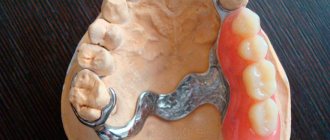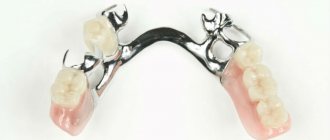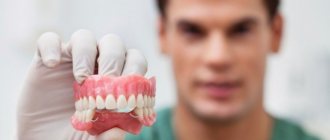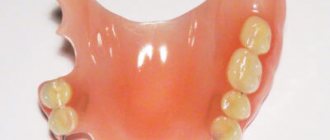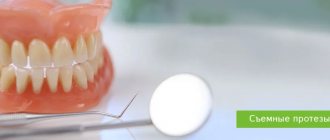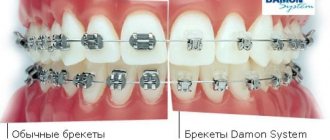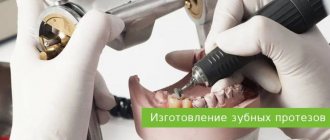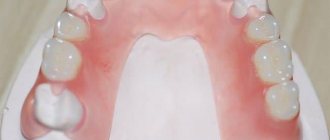- Advantages and disadvantages
- Kinds
- Indications
- Stages of treatment
- Care
- Alternative Methods
- Advantages of the ROOTT Clinic
- Prices
- Work examples
- Doctors
- Reviews
Losing teeth often leads to a decrease in self-esteem: people try to talk less, smile less often, and do everything not to attract attention to themselves. Orthopedists are developing different methods to restore quality of life. One such method is acrylic dental prosthesis.
- When used:
missing from 1 tooth to completely edentulous - Type of anesthesia:
no need - Procedure time:
from 30 minutes (up to 4 visits) - Treatment period:
from 1.5 weeks to 3 weeks - Healing period:
from 3 weeks after the last removal - Age restrictions:
from 18 years old (in our clinic)
Acrylic has been used as a material for prosthetics for many decades and it still remains the most popular. Several factors influence this.
Pros and cons of acrylic prosthesis
There are no perfect methods for restoring teeth. Each case must be considered individually. The orthopedist takes into account all anatomical and physiological features before deciding on a specific prosthetic method. It should be noted that acrylic dentures have disadvantages. The main one is related to the composition: during production, a monomer (methacrylic acid ester) is used, which reacts with mucosal proteins, causing allergic reactions in a certain percentage of patients. These reactions can be local (allergic contact dermatitis, allergic stomatitis) and general, up to angioedema.
Advantages
- Availability - prices for acrylic prostheses are lower than for structures made from other materials;
- wear resistance - acrylic is hard, products made from it can last up to 8-9 years;
- resistance to chemical influences - sour, sweet, salty - acrylic calmly reacts to chemical irritants, does not change color or shape;
- weight - plastic - the material is light, the patient does not feel much pressure on the teeth, after a period of adaptation the denture does not interfere in the mouth;
- ease of manufacture - production technologies are well developed, products can be manufactured in any laboratory;
- ability to be modified - the properties of acrylic allow you to choose any shape, shade and size of the product;
- ease of installation - the prosthesis is installed in 2-3 visits;
- inexpensive repair.
Flaws
- Porosity of the material - during production, micropores appear in plastic, and this is an opportunity for bacteria to accumulate and cause infections;
- insufficient resistance to variable loads during chewing - despite wear resistance, the structure may break under load, but it can be easily repaired;
- low elasticity - in unusual cases, such as growths on the jaw (exostoses), sharp bone protrusions, increased pain sensitivity, acrylic dentures can cause severe discomfort;
- progressive atrophy of bone tissue - only implantation can slow down bone loss, in other cases it will increase.
Habituation and care
The psychological aspect associated with wearing acrylic dentures is perhaps the main problem for visitors. The awareness of the presence of a foreign body in the mouth is unusual for many. At first, diction may change, difficulties with eating and swallowing saliva may occur, and some patients experience gag reflexes even if the product is performed perfectly. This is a normal phenomenon; interfering imperfections go away on their own after a few days. But the opportunity to gnaw apples and nuts and give others a dazzling, even smile cannot but inspire those who decide to install acrylic teeth.
To get used to acrylic dentures as quickly as possible, you need to do exercises for the tongue, lips and cheeks. It is useful to repeat tongue twisters, sing and read poetry out loud, and do not be shy to communicate with family, friends, and colleagues. The more conversational practice, the easier and sooner the patient will return to his usual way of life. We should not forget about regular oral hygiene. Caring for plastic dentures is simple and practically no different from the usual everyday procedures. Nevertheless, doctors advise that at first you follow certain recommendations that will help you care for and get used to plastic teeth.
- We need classes on speech technique, as mentioned above - a simple and short way to normalize diction, the ability to pronounce any, even the most complex words without hesitation.
- During the first two weeks, you should not subject acrylic dentures to high loads. It is better to eat soft foods: porridge, purees, yoghurts, mousses.
- Doctors recommend not removing acrylic dentures at first, even at night: constant presence in the mouth will allow you to quickly get used to the new realities.
- In the future, you need to eat right, include seafood, vegetables, fruits, cheeses, cottage cheese and other dishes rich in useful minerals and trace elements in your diet.
- You should not smoke a lot and abuse products containing strong food dyes: coffee, chocolate, sweet soda. Plastic teeth will quickly darken.
- It is important to strengthen your immune system by regularly being in the fresh air. However, in the first month you should not expose the body to high aerobic and anaerobic stress.
- For six months after installing acrylic dentures, it is better to refrain from visiting the bathhouse, long-distance travel, and air travel.
- Be sure to remove and clean the products every day with a medium-hard brush. After a snack, you should rinse your mouth with water or antiseptic solutions.
- If you are removing plastic dentures, place them in a container of water. Once a week, you need to disinfect products using special soluble tablets.
- It is necessary to visit the dentist at least once every six months for a routine examination or professional cleaning of acrylic dentures.
IMPORTANT! If the patient notices that there is a burning sensation in the mouth, dryness, excessive salivation, taste sensations have changed, normal speech is not restored for a long time, or redness of the soft tissue of the gums is observed, you should immediately consult a doctor. The listed symptoms may indicate a possible allergy to acrylic. In this case, you will have to apply therapeutic treatment or replace plastic dentures with nylon products.
Types of products
Acrylic products are used in dentistry if all or part of teeth are missing. Therefore, it is customary to divide dentures into:
- Full.
Used in cases of complete absence of teeth. - Partial.
An acrylic partial denture is placed when there are teeth that can be used as support. - Butterfly.
It is attached to adjacent teeth, so it is used only when 1-2 teeth are missing.
Depending on the wearing time, the designs can be:
- temporary;
- permanent.
Temporary dentures are used while permanent ones are being made or while implants are taking root. When using basal implantation methods, All-on-4, All-on-6 methods, such systems are made non-removable.
We use only the latest materials and equipment, including new generation acrylic. At Nordent you can restore the beautiful appearance of your smile at affordable prices and with a guarantee of quality!
Features of prosthetics for complete or partial edentia
New generation acrylic dentures are primarily used for partial or complete edentia. If at least a few living teeth remain in the oral cavity, they can be used as support. In such a situation, in addition to the acrylic base, the design will include hooks made of translucent acrylic. They will be located at the base of the supporting teeth. Since acrylic completely imitates the color and even the structure of the gums, the fastening elements will merge with the mucous membrane and are difficult to notice. This significantly improves the aesthetics of such prostheses.
Another advantage of such structures for partially edentulous patients is the minimal load on the remaining teeth, since acrylic is a very light material. Indeed, with increased pressure from the prosthesis, the supporting elements are destroyed very quickly. That is why the use of new generation acrylic prostheses in this situation is very justified.
The structures will also cope well with complete edentia. In such a situation, they will be fixed exclusively on the gums. Like any other dentures designed for the entire dentition, they will literally stick to the gums. Designs for upper jaw prosthetics provide an overlap for the palate, which will provide better fixation. Modern acrylic is more flexible and soft than classic plastic, which is used to create plate dentures. At the same time, it is less elastic than nylon, due to which the service life of the prosthesis is much longer - the structure does not stretch several months after the start of use, which makes it possible not to use fixing gels for a longer time.
Features of prosthetics on implants
New generation acrylic is the number one material used in prosthetics on implants, or more precisely, when choosing immediate loading methods. This is explained by the following characteristics:
1. The material is lightweight and does not cause implant displacement
A prosthesis using acrylic is very light, so it is recommended for implantation methods that involve immediate loading, for example, all-on-4, all-on-6. When choosing one-stage implantation methods, a new generation acrylic prosthesis allows you to hide the uneven contour of the gums and does not put excessive pressure on implants that have not yet fused with the bone tissue.
2. The strength of the material ensures stabilization of implants and uniform load on the bone
Acrylic is a fairly durable and relatively hard material. When fixed to implants, the size of the prosthesis is noticeably reduced. In addition, the structure is securely fixed and discomfort is completely eliminated - the patient can only get used to the fact that new teeth have appeared in the oral cavity.
In addition, acrylic is a very flexible material and is securely fixed to the metal base of the prosthesis. It, in turn, acts as a kind of retainer or splint, connecting and stabilizing the installed implants and preventing them from moving as a result of chewing load. Thanks to this, the patient gets the opportunity to fully use the new teeth for chewing food, allowing the implants to fuse completely safely with the bone tissue.
3. The material is subject to repair and correction
This is also one of the most important advantages of acrylic - in the presence of installed implants, bone tissue is restored and the bite changes. Therefore, it may be necessary to reline the prosthesis - the process takes several hours and does not require damage to the structure. Similarly, when fixing on supporting teeth, adjustment of the prosthesis may be required if a living tooth is destroyed, or if the attachment breaks.
Similarly, when fixing on abutment teeth, adjustments to the structure may be required if a living tooth is destroyed, if the fastening is broken, as well as due to subsidence of bone tissue, which inevitably occurs when wearing removable appliances.
Disadvantages of acrylic dentures
Acrylic dentures are the most budget-friendly option for prosthetics, both classic removable and when fixed on implants. However, it has certain disadvantages, especially in comparison with other prosthetic models:
- relative strength;
- less aesthetic appearance;
- possible chips of plastic (veneering of crowns);
- changes in the appearance of the prosthesis as a natural consequence of use, as well as due to insufficient hygiene;
- lack of protection against jawbone atrophy when choosing classic removable dentures without implant support;
- short service life - no more than five years.
In addition, an acrylic prosthesis has a more rigid structure than, for example, nylon ones, which means that getting used to it when installing full-arch prosthetics will take longer.
Service life of new generation acrylic prostheses
Modern acrylics fully serve up to 5 years. However, no more is required - when fixed to living teeth, the prosthesis will still have to be changed, since the roots may not withstand the load and over time they will have to be replaced with implants.
As for implantation, an acrylic prosthesis is used as a temporary option in a classic two-stage approach - it is installed for the period of engraftment of the implants in the bone tissue (this is about six months). When choosing one-stage implantation, the acrylic structure acts as an adaptation prosthesis - it is installed for six months to a year. However, after this time, the patient can keep this prosthesis and replace it with a more aesthetic permanent structure after the end of its service life. But no later than three years after installation, since the plastic (used to create crowns) tends to wear down and loss of bite is possible after it is aligned on the implants.
How to quickly get used to removable dentures
Naturally, each person is individual, and the duration of adaptation directly depends on the model and materials of construction. Conventionally, the process of addiction can be divided into three stages:
- irritation stage, which lasts about 7-10 days;
- stage of conditioned inhibition (duration – 3 weeks);
- the stage of full adaptation, when the patient completely gets used to the new artificial teeth (occurs after 30-40 days).
Immediately after installation, removable dentures may cause you nausea, increased salivation, changes or complete loss of taste, and difficulty eating. Diction problems also occur. But as you get used to the design, all manifestations disappear completely or are reduced to a minimum.
During the period of getting used to the prosthesis, you need to wear it constantly, without removing it while eating and sleeping. You should not use it in case of acute pain - it is better to consult a doctor to correct the design.
How to restore diction
To restore diction, it is recommended to speak as much as possible: read books, pronounce tongue twisters, while holding one or more sweets in your mouth (no sugar!). 15-20 minutes, several times a day. The duration of the course is the first 1.5-2 weeks after prosthetics.
What to do if the prosthesis rubs and does not fit well
- use ointments (Solcoseryl, Metrogyl Denta) or sea buckthorn oil. Apply the oil to the gums for a maximum of 20 minutes after eating and cleaning the denture 3-4 times a day;
- It is forbidden to sharpen dentures yourself, after which it can simply be thrown away;
- If there is acute and constant pain caused by rubbing of the structure, you should consult a doctor for correction. 2-3 hours before the visit, the denture should be in the mouth so that the reason why the structure is rubbing becomes visible.
If the device is not fastened well, then you should contact your attending physician - an orthopedic dentist. If the correction does not help, you will have to use special fixation creams: Protefix, Corega, Lacalut Dent. Choose the one that suits you - according to taste, consistency, fixation time. Try different options and choose the best one.
How to eat after installing structures
If the prosthesis is made of comfortable materials, if it suits you, then you will be able to eat well right away. Restrictions occur when little time has passed after the removal of living teeth, when you initially had gum inflammation. In such situations, pressure causes pain; you need to limit the chewing load to avoid discomfort and allow the gums to recover.
In general, during adaptation it is advisable to adhere to the following recommendations:
- give preference to soft and warm foods, exclude viscous foods;
- you need to chew carefully and thoroughly, cut food into small pieces;
- It is better to chew food on the side where the process does not cause pain;
- You should refrain from biting food with your front teeth.
After adaptation, when the prosthesis no longer causes pain, you can return to your usual diet. But you should exclude foods that are too hard, viscous, sticky, excessively hot and cold (drinks and soups should be warm, ice cream should be kept a little at room temperature).
How to clean dentures and remaining teeth
You need to brush your teeth exactly as you are used to: in the morning, in the evening and after each meal. But as for prosthetics, the recommendations will be as follows:
Daily care
- clean the structure in the morning and evening with a soft toothbrush using toothpaste without abrasives or regular soap (preferably baby soap). Pay special attention to the internal area that is in contact with the gum;
- Soak the denture daily in a solution of citric acid (1 teaspoon per 150 ml of warm water): soak it for 10 minutes to disinfect and loosen plaque. Carry out the procedure before brushing your teeth 2 times a day. Afterwards, rinse thoroughly with water. Change the solution every 3-5 days,
- after each meal, the structure is removed and thoroughly rinsed under running water;
- Additionally, you can use an irrigator, which will allow you to clean the microscopic gaps between the crowns of the structure;
- Be careful when brushing your teeth, especially if there are small parts - hooks, clasps, so as not to damage them.
Periodic care
- soak in a disinfectant solution - for this you need to purchase special tablets for removable dentures (Protefix, Corega, Lacalut Dent). Use up to 3 times a week while maintaining daily hygiene. Use according to instructions (keep in solution for 15-20 minutes);
- use products that suppress the activity of oral microflora (especially important several years after the installation of dentures, since more plaque accumulates on them). For example, “Tantum Verde” (spray, lozenges) - relieve inflammation and tension, freshen breath.
Modern equipment - ultrasonic sterilizers - can be used to disinfect dentures. They allow you to achieve ideal cleanliness of artificial teeth at home, cleaning them from bacteria and plaque. These devices can also be used to disinfect any other items - toothbrushes, baby bottles, etc.
Do I need to remove dentures at night?
Modern “removers” can be worn constantly and it is not necessary to remove them at night – especially during the first 2-3 weeks, while adaptation to the designs occurs. However, outside the oral cavity, dentures with a plastic base should NOT be placed in a humid environment, since favorable conditions are created for the development and growth of pathogenic microflora. This can lead to bleeding and gum inflammation.
If there are metal elements, the prosthesis must also not be stored in tap water, especially chlorinated water - this can lead to metal corrosion.
For storage and transportation, it is necessary to use specially designed protective ventilated boxes/cases in which the prosthesis will be kept clean and dry.
Why does increased salivation occur?
Salivation occurs due to the fact that a foreign body appears in the oral cavity, and it is quite massive - removable dentures, as a rule, cover the palate and completely hide the gums. Therefore, our body is given a signal that something has appeared in the mouth and it needs to be digested. Over time, restructuring will occur, but, unfortunately, at first this problem cannot be solved.
Is it possible to whiten dentures?
If hygiene is insufficient, dentures may change their shade. But, unfortunately, it is impossible to bleach it to its original state, especially if a lot of plaque has accumulated and the coloring pigments have penetrated deep into the pores of the material. The doctor can perform polishing - the prosthesis will be smoother, its top layer will be a little ground off, so the structure will be visually lighter. At home, you can try using special whitening tablets (for example, Corega), but you should not overuse them - they can damage the prosthesis materials.
How to know when it’s time to change your dentures
It is recommended to change dentures every 3-5 years or 5-7 years (depending on the material and type of construction).
When using removable dentures, the load from chewing food on bone tissue is only insignificant, which is fraught with its gradual resorption. The jawbone decreases in size, and not always evenly. This process takes from six months to several years and leads to a discrepancy between the shape of the prosthesis and the relief of the gums - the prosthesis is less secure and becomes less stable. This means relocation (if possible) or complete replacement of the structure is required.
In addition, materials wear out over time under the influence of saliva, nicotine, food irritants, and mechanical stress. Cracks appear on the structure, the surface becomes less smooth, which contributes to the accumulation of a large amount of plaque. If you have chosen crowns made of plastic (namely, they are in most cases used in removable orthopedic devices), it is worth considering that they wear down quite quickly, so after about 2-3 years a change in the bite occurs, which can affect the condition of the joint and the process of normal chewing food.
Who is suitable for acrylic dentures?
First of all, to those who do not have allergic reactions to it. This is the main condition and should be discussed with your doctor before making a choice.
Acrylic dentures are suitable for:
- complete edentia;
- partial edentia;
- the impossibility of using other methods of dentition restoration;
- temporary prosthetics.
The method has contraindications:
- in the development of allergic reactions
. The risk group includes patients with bronchial asthma, food allergies, reactions to medications, and problems with the endocrine system. - The anatomical features
of the oral cavity do not always allow the installation of a structure made of hard plastic. For example, with a sharp, thin or overhanging alveolar ridge, such a prosthesis will be impossible to wear.
Areas of application of prostheses
Acrylic dentures are primarily used to correct dental defects, but they are used not only by elderly patients who have lost teeth. They are designed to give an aesthetically attractive appearance to the oral cavity.
Among dental office clients seeking removable dentures:
- elderly people – come with the problem of excessive tooth loss and loss of chewing functions
- young people - resort to dentures as a temporary solution for the period of gum healing after tooth extraction
- children - wear dentures to form a correct bite in case of uneven or early loss of baby teeth
In most cases, acrylic removable dentures are installed if fixed prosthetics are not possible. But their popularity is also due to their low cost.
Stages of manufacturing and prosthetics
The dentist begins the procedure with an initial examination. It determines the scope of work and the need for preliminary manipulations. The oral cavity is sanitized before prosthetics; if necessary, damaged teeth are removed. Crowns are placed on those that are intact according to indications.
- Upon completion of the preparatory stage, the doctor takes impressions of both jaws, even if a removable acrylic denture is intended for only one jaw.
- In the laboratory, a plaster model is made from casts
- After this, the technician forms a wax model and sends it for fitting.
- The orthopedist performs a fitting in the patient's mouth, notes any imperfections, and returns the model back to the laboratory for adjustments.
- A plastic prosthesis is made based on the wax model.
- The finished product is ground, polished and sent to an orthopedist
- The doctor installs the structure and provides instructions on use and care.
A complete acrylic denture on the upper jaw holds up better. Due to the hard palate, the suction effect is higher. Typically, such products do not require additional funds. There is not enough space on the lower jaw for a foundation; for better fixation, you need to use a special cream.
Partial dentures are held in place by special anchors in both the lower and upper jaws. The main condition is the presence of supporting teeth.
Other options for removable prosthetics:
Nylon dentures
Clasp dentures
Dyatlov Evgeniy Valerievich
Head of the Denta-Labor laboratory and teacher at the training center organized at the laboratory.
Graduated from Stavropol Basic Medical College.
Author of the article: Scientific team of the dental laboratory Denta-Labor
- Studied in Germany with Dr. Karl Peter Meschke in the course of complete removable prosthetics.
- I attended a course of lectures at the German Dental Academy based at BEGO (Bremen).
- Completed a week-long internship in Germany at the BEGO company on new technologies and materials for removable prosthetics.
How to care for a removable acrylic denture on the jaw
If the prosthesis is fixed, on implants, then it is cared for in the same way as your own teeth. It is enough to carry out hygiene procedures regularly. No additional manipulations are required.
If the product is removable, it is recommended:
- remove and rinse the jaw in running water after each meal;
- use a waterpik to get rid of stuck crumbs;
- Brush your remaining teeth regularly. If there are no teeth, wipe the gums with mouthwash;
- when using a fixative cream, rinse your mouth thoroughly after eating;
- clean the product with a soft toothbrush and regular low-abrasive paste;
- regularly disinfect jaws with special tablets or use sterilizers.
During adaptation, orthopedists recommend wearing the prosthesis around the clock. It can then be removed at night. Store the system in boiled water or a special liquid from a pharmacy. If necessary, you can simply wrap it in a napkin. Modern materials do not dry out in the air, but it is better to consult a doctor on how exactly to store an artificial jaw.
According to patient reviews, putting on the prosthesis “dry” is not very convenient, but you can get it wet if you do not use a retainer. The cream is applied only to a dry surface.
How can I replace acrylic?
If you have allergies, don't worry. Prostheses made of acrylic plastic can be replaced with nylon products. They are softer, more elastic, and easier to get used to.
But they also have drawbacks. Such products distribute the chewing load unevenly, increasing it at the bite site. They are prone to deformation. There are no ideal materials; before choosing, you need to consider all the pros and cons.
| Property | Acrylic | Nylon |
| Possibility of allergic reactions | Eat | No |
| Price | Relatively low | Relatively high |
| Presence of metals | Yes, in partial dentures | No |
| Elasticity | Low | High |
| Probability of fault | High | Low |
| Weight | Easy | Easy |
| Fixation | good | Worse than acrylic |
| Possibility of repair | Eat | No |
| Aesthetics | Average | High |
| Risk of loosening of supporting teeth | High | Short |
| Terms of adaptation | For a long time | Fast |
What is better - nylon prostheses or acrylic ones, the doctor decides in each specific case, taking into account the wishes of the patient.
The new AcryFree material is a compromise between nylon and acrylic. It does not contain monomers and does not cause allergic reactions. In this case, the systems:
- Moderately hard.
Softer than acrylic, but hard enough to distribute the load evenly. - Comfortable.
The AcryFree base is thin; the partition on the upper jaw does not block the taste buds. - Easily fixed.
More flexible than acrylic ones, such dentures adhere well and do not rub the gums. - They have a natural look.
Clasps (clasps) are made from the same material, and the base itself imitates natural fabric, so the prosthesis is hardly noticeable.
Like acrylic systems, AcryFree systems have a rather long period of adaptation. You need to take care of them very carefully, they are more fragile than nylon.
Dental implantation A reliable and durable method to restore a smile in the absence of teeth
Nylon dentures An elastic and damage-resistant denture is attached by suction to the gum or using clasps to the supporting teeth
AcryFree dentures Comfortable and elastic systems, do not deform under chewing loads, maintaining aesthetics; do not cause allergies
The most advanced method of dental reconstruction is implantation. Thanks to it, you can restore any number of teeth. Implants stop bone loss. They are as close as possible to natural teeth in function and appearance.
Article Expert
Shirokov Ivan Yurievich Dentist-orthopedist, doctor of the highest category
Work experience: more than 17 years
Allergic reactions
Sometimes people wearing acrylic dentures complain of the following symptoms:
- inflammation and swelling of the mucous membranes of the mouth, lips, tongue, gums;
- copious amounts of saliva;
- burning and dry mouth;
- change in taste sensations;
- malaise, drowsiness, lethargy.
Such phenomena are caused by an allergic reaction. The fact is that when chewing, the denture experiences heavy loads, which leads to deformation. It is also affected by the biological environment of the oral cavity (saliva, microflora, temperature, etc.). This releases a residual monomer, which is a toxicogenic factor that causes allergies in some patients.
Plasticizers and dyes contained in the prosthesis material, additives that increase flexibility, and stabilizers that increase wear time can also become allergens.
If you experience the phenomena described above during use, contact your dentist. Perhaps wearing an acrylic prosthesis is contraindicated for you, and you will have to replace it with nylon or silicone.
Where to put
In Moscow, placing a removable acrylic denture on the jaw is not difficult. But making a system in a tiny laboratory is one thing, but making it in a modern one, equipped with the latest technology, is quite another. Shrinkage of acrylic plastics can reach 6-8% and only careful adherence to technology can reduce it to a minimum. A well-equipped laboratory is suitable for this, but a small one is not. Shrinkage determines how accurately the prosthesis “fits” on the jaw.
MCDI ROOTT has its own laboratory, orthodontists and laboratory assistants work in one team. New equipment and experienced doctors guarantee the quality of prostheses.
What is the price
The price depends on the amount of work and its complexity, but the RUTT clinic does everything to reduce the financial burden. The center offers the opportunity to pay for prosthetics in installments and take out a loan. You will be given documents for a tax deduction, and by subscribing to the newsletter, you will know about all promotions and discounts. Sign up on the website and get professional advice for free.
Free online consultation with a dentist
| Service | Price |
| Installation of a temporary cosmetic plate (butterfly) | from 11,000 rub. |
| Installation of a complete or partially removable lamellar denture (acrylic, 1 jaw) | from 32,000 rub. |
| Conditionally removable acrylic prosthesis on spherical attachments Rhein-83 for 1 jaw | from 121,000 rub. |
Consultation and diagnostics are free!
All prices Promotions



